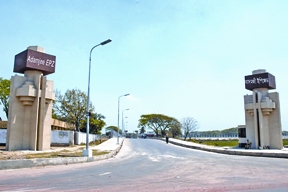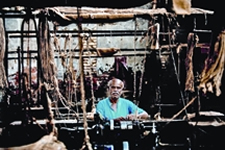Adamjee Jute Mill

Adamjee Jute Mill established at narayanganj near dhaka in 1950, is one of the largest jute mills of the world. It was, however, closed in 2002 on account of its recurring losses and labour unrest. At the time of partition of bengal in 1947, there were 108 jute mills in Bengal but all of them fell within the territory of India. The government of Pakistan encouraged Muslim entrepreneurs to come forward with proposals for establishment of jute mills in the country, following which Adamjee Brothers of calcutta agreed to act as a promoter and presented an investment plan in December 1949. In line with its proposal, Adamjee Brothers contributed 50% of the share capital while the Pakistan Industrial Development Corporation (PIDC) sanctioned the rest of the capital. The proposed site for the new mill was Siddhirganj, about six kilometres north of Narayanganj, which had good river, road and rail communication facilities. Two hundred twenty seven acres of land was acquired and developed for the construction of the mill. PIDC arranged for import of machinery and equipment for the mill with government grants of foreign exchange and by June 1955, the mill was ready for commissioning and had 3000 looms and 31200 spindles. The production capacity of the mill was 117 ton of twist and yarn, 953 ton of hessian and 4006 ton of sacking bag. The mill became an abandoned property in 1971 and its ownership and management were vested on Bangladesh Jute Mills Corporation in 1972.
The mill has 18 departments. Those include production, quality control, marketing, personnel, engineering, finance, and public relations. Initially, the mill followed the traditional system of record keeping and accounting, replaced by the Integrated Accounting System (IAS) in 1967. The new system provided ready data for cost control and managerial decision purposes. Until 1971, the Adamjee family controlled the management of the mill, although the government had intervened from time to time as an equal partner.
After nationalization in 1972, the Adamjee Jute Mill started suffering from problems like overstaffing, lack of work discipline, absenteeism and unionism. The new management failed to ensure product quality and the output of the mill could no more meet the specifications of overseas buyers. The situation gradually got worse and the mill started incurring losses, a trend which could never be reversed. Because of continuous losses incurred by the mill every year, the government closed it on 30 June 2002.

In 1999-2000, the mill had 1,939 looms for hessian, 1,103 for sacking and 234 for carpet backing cloth (CBC). The looms in operation were 1085 for hessian, 726 for sacking, and 172 for CBC. Budgeted weaving production was 19,002 ton of hessian, 34,609 ton of sacking and 6,004 ton of CBC for the year. Actual production, on the other hand, was 10,284 ton of hessian, 21,236 ton of sacking, and 3,254 ton of CBC. The mill had 515 officers, 1,561 support staff and 16,443 workers. Man-days per ton estimated for 1999-2000 were 218 for hessian, 94 for sacking and 131 for CBC, which were 189, 88 and 112 respectively in 1995-1996.
The Adamjee Jute Mill has more manpower than it actually requires for production of hessian, sacking and CBC. Also, the man-days required to produce these items have also increased in the last five years. The mill has, however, achieved some improvements in terms of use of raw materials. In 1995-1996, the raw jute required to produce a ton of hessian per ton was 1,672 kg, a ton of sacking 1,494 kg and a ton of CBC 1,813 kg. The comparative figures for 1999-2000 were 1,281 kg for hessian, 1,104 kg for sacking, and 1,447 kg for CBC. A rise in the wage cost per ton from Tk 23,092, 15,780 and 22,248 for hessian, sacking and CBC respectively in 1995-1996 to Tk 27,248, Tk 18,596 and Tk 25,800 respectively in 1999-2000 has, however, offset the economy achieved in use of raw materials. Bangladesh Government has recently announced that the Adamjee Jute Mill will be reopened, if needed by private entrepreneurs. [M Habibullah]
